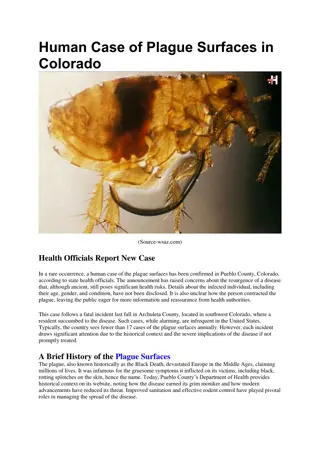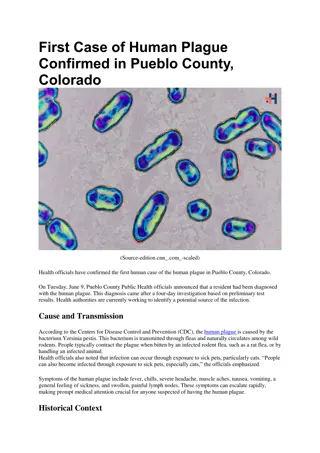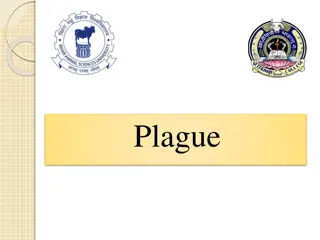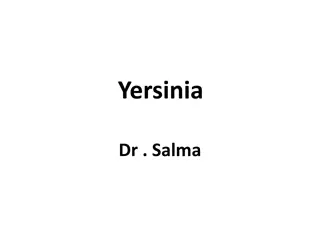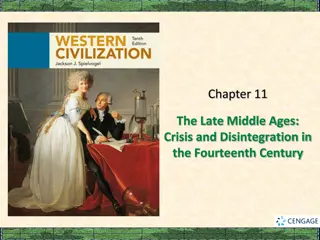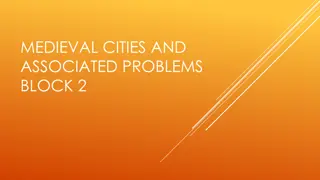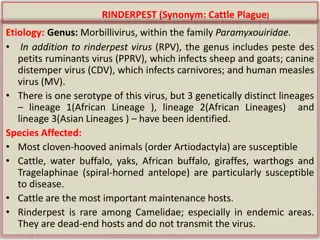Human Case of Plague Surfaces in Colorado | healthcare
In a rare occurrence, a human case of the plague surfaces has been confirmed in Pueblo County, Colorado, according to state health officials.
0 views • 2 slides
Evolution of Medicine in Colonial South Asia
The evolution of medicine in colonial South Asia witnessed a transition from local traditional practices to the dominance of imported European medicine. This shift, marked by the establishment of imperial institutions and training of local physicians in Western techniques, led to a complex interplay
1 views • 5 slides
First Case of Human Plague Confirmed
Health officials have confirmed the first human case of the human plague in Pueblo County, Colorado.
0 views • 2 slides
Understanding Yersinia: Characteristics, Diseases, and Identification
The genus Yersinia includes various species, with Yersinia pestis causing plague and others causing diarrheal diseases. Yersinia organisms are gram-negative rods, often associated with serious infections. Learn about Yersinia pestis, its transmission, identification, morphology, and antigenic struct
0 views • 32 slides
Insights into the Plague: Epidemiology, Etiology, and Outbreaks
The Plague, caused by Yersinia pestis, has a chilling history spanning pandemics like the Justinian Plague and the Black Death. Understanding its etiology, family, and pathogenicity is crucial. This deadly disease has had notable outbreaks in India, emphasizing the importance of recognizing its host
0 views • 24 slides
Understanding Yersinia Pestis: The Bacterium Behind the Black Death
Yersinia pestis, the causative agent of the infamous Black Death, is a Gram-negative coccobacilli bacterium. It is transmitted through fleas and affects lymph nodes, causing bubonic plague. This article explores its general characteristics, pathogenesis, virulence factors, laboratory diagnosis, and
0 views • 18 slides
The Devastating Impact of the Bubonic Plague in Medieval Times
The Bubonic Plague, caused by the bacterium Yersinia pestis, ravaged Western Europe during the late Middle Ages, resulting in over 75 million deaths. Spread through rats carrying infested fleas, the disease caused agonizing swellings and ultimately death, with no known cure in the 1300s. The unsanit
0 views • 11 slides
The Late Middle Ages: Crisis and Disintegration in the Fourteenth Century
The fourteenth century in Europe was marked by the devastating impact of the Black Death, economic dislocation, social upheaval, and political instability. The bubonic plague wiped out a significant portion of the population, leading to labor shortages and peasant uprisings. The decline of the papac
1 views • 24 slides
European History in the Fourteenth Century: Adversities, Wars, Art, and Plague
The fourteenth century in Europe was marked by various adversities such as the Hundred Years' War, the Black Death, and political upheavals. Despite these challenges, there were significant developments in literature and art. The Avignon Papacy also shaped the religious landscape of the time, while
0 views • 8 slides
Challenges and Triumphs of European Trade in the Fourteenth Century
Despite the revitalization of European trade due to the Crusades, emerging nation-states faced obstacles to sustainable growth in the fourteenth century. The era was marked by tensions within monarchies, vulnerability of economic institutions to crises like the Bubonic Plague, and conflicts such as
1 views • 16 slides
The Devastating Impact of the Black Death in Europe: Origins, Spread, and Consequences
The Bubonic Plague, also known as the Black Death, ravaged Europe between 1347-1352, wiping out nearly 1/3 of the population. Originating from the Orient Rat Flea transported to Europe through trade routes, the disease caused severe symptoms such as enlarged lymph nodes, headaches, and skin discolor
0 views • 20 slides
Analysis of Blame and Tragedy in Oedipus the King and Aristotle's Poetics
The question of blame is central in "Oedipus the King," where the city faces a plague and seeks accountability. Aristotelian concepts of tragedy, as outlined in "Poetics," delve into the structure and components of a tragic work, emphasizing plot development and cathartic emotions of pity and fear.
0 views • 28 slides
Medieval Cities and the Impact of the Black Plague
Explore the revival of trade in Medieval Europe, its effects on city growth, and the devastating spread of the Bubonic Plague. Learn about the causes, spread, and impact of the Black Plague, as well as its symptoms and the challenges faced by growing cities during the medieval period.
0 views • 17 slides
Homeric Greek Vocabulary Lessons 26-30: Learn Key Words and Meanings
Explore and enhance your understanding of Homeric Greek with vocabulary lessons 26-30. Dive into the meanings of words like "plague," "dream," "think," and more. Strengthen your grasp on this ancient language through interactive quizzes and visual aids.
0 views • 62 slides
Transforming Urban Areas: Smart Mobility Strategies
Explore the concept of smart cities and the inefficiencies that plague urban environments through the lens of waste management, housing energy usage, and mobility patterns. Discover a strategy for implementing smart mobility solutions to enhance quality of life and reduce waste, making cities more a
0 views • 23 slides
Infectious Disease Control in the Russian Federation
Infection control in the Russian Federation is managed by various agencies and organizations, with a focus on surveillance, prevention, and outbreak response. The country registered millions of cases of infectious diseases, with upper respiratory tract infections being prevalent. The anti-plague ser
0 views • 16 slides
Understanding Rinderpest: A Cattle Plague Overview
Rinderpest, also known as Cattle Plague, is caused by the Morbillivirus and primarily affects cloven-hooved animals like cattle and buffalo. It is transmitted through contact with infected animals and has distinct clinical signs ranging from fever and mucopurulent secretions to severe hemorrhagic di
0 views • 14 slides
